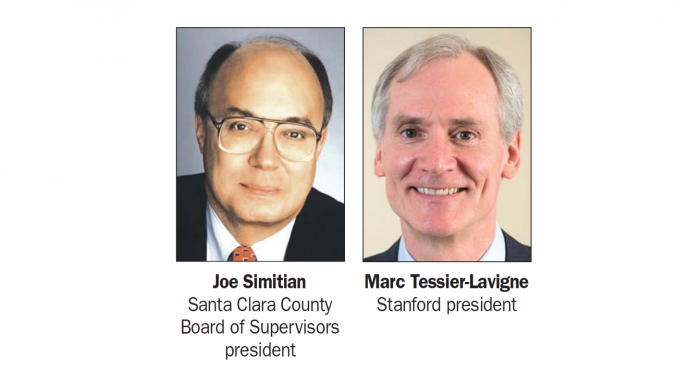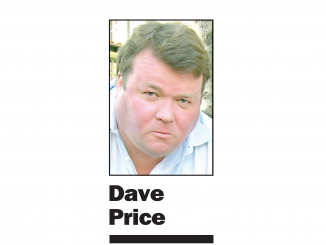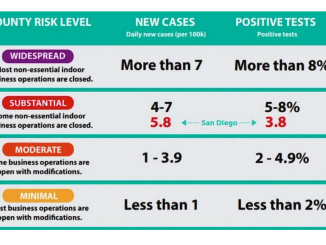
BY ALLISON LEVITSKY
Daily Post Staff Writer
Stanford officials say they still want to give the Palo Alto school district $138.4 million in per-student funding over 40 years and construction money, claiming that Santa Clara County Board of Supervisors President Joe Simitian was incorrect when he told the Post this week that the university wanted to pull back.
“During all of our discussions with the county, we proposed to provide the full package of benefits to PAUSD,” Stanford spokesman Joel Berman told the Post on Friday (May 17). “We did not suggest removing upfront payments from the benefits package nor did we suggest any other modification to the benefits package for PAUSD.”
But Simitian said Friday (May 17) that university President Marc Tessier-Lavigne and Vice President of Land, Buildings and Real Estate Robert Reidy had “quite clearly” proposed a lesser offer for the school district in a phone call on May 8.
“There were three other people in my office on that call, all of whom heard the lesser offer, including one of my colleagues on the Board of Supervisors,” Simitian told the Post, referring to Board of Supervisors Vice President Cindy Chavez. “And all three of them have confirmed the fact that there was, in fact, a lesser offer.”
Dispute over $16.5 million for construction costs
Simitian said that in that phone call, Reidy and Tessier-Lavigne had offered per-student funding to the school district, but pulled back the $16.5 million that it had previously promised for construction costs.
“They were very explicit about not including that $16.5 million,” Simitian said. “This is why I’ve suggested we should have these kinds of conversations in an open and public setting.”
In a statement on the university website yesterday, Stanford officials said that contrary to “recent news reports,” Stanford had been “steadfast in its commitment to the full scope of benefits for the school district.”
“Stanford and the county discussed different options for how to structure the agreement, but Stanford was very clear throughout those deliberations that it was still willing to provide all of the benefits in the agreement,” the statement reads.
Berman declined to specify what those different options were.
‘Intended to be confidential’
“Our discussions about the structure of the agreement were intended to be confidential,” Berman told the Post. “Given that we reached no agreement on a structural change, we have withdrawn that suggestion.”
As Stanford seeks approval for a 3.5 million-square-foot expansion, the university will be asked to comply with “conditions of approval” recommended by county planners, which are set to be released on Thursday (May 23).
A summary of those conditions released in March calls on Stanford to build between 2,172 and 2,892 housing units and between 2,600 and 2,807 student beds.
The county is asking Stanford to build at least 70% of the market-rate units and 40% of the affordable units to be built on campus, with any off-campus units built within 6 miles of campus.
Stanford only wants to build 3,150 housing units or student beds, including up to 550 housing units for employees.
After those conditions are released, the county Planning Commission and Board of Supervisors will discuss them publicly, consider feedback from the public and Stanford, then approve a set of conditions by which Stanford must abide.
Conditions of approval vs. development agreement
But Stanford doesn’t want to be subject to a publicly discussed set of conditions of approval, which are a typical part of the process for approving development in California.
Instead, Stanford wants to negotiate the terms of its expansion behind closed doors through a development agreement, a deal in which a developer promises public benefits, such as funding for affordable housing, public transportation or schools, in exchange for permission to build.
On May 3, Simitian and Chavez told Tessier-Lavigne and Reidy that they were willing to reopen negotiations for a development agreement if the university would give the school district a funding deal at least as rich as its previous $138.4 million offer, and if the development agreement would be negotiated in public.
But on May 8, Simitian said that Tessier-Lavigne and Reidy said they only wanted to negotiate the development agreement in private and didn’t want to be subject to conditions of approval.
On top of that, Reidy and Tessier-Lavigne said they didn’t want to give the full $138.4 million deal to the schools, Simitian said.
“They said explicitly that they were not prepared to provide the $16.5 million in construction benefits as part of a bilateral deal not contingent on a successful development agreement,” Simitian said.
Stanford made that $138.4 million deal with the school district, but withdrew it on May 10 after the university and the county failed to negotiate a development agreement.
Strings attached to Stanford’s offer to schools
The deal with the school district would have been contingent on a successful development agreement, which Simitian claimed amounted to Stanford holding a gun to the county’s head.
School board member Ken Dauber has since criticized Simitian for “killing” that deal, stating at Tuesday’s school board meeting that Simitian likely wouldn’t get the same amount of funding for the school district out of Stanford.
After the conditions of approval for Stanford’s expansion are released on Thursday, members of the public will have the opportunity to give feedback on them at the county Planning Commission meeting at Palo Alto City Hall on May 30.
Only a fraction of the local news stories covered by the Daily Post appear on this website. To get all the local news, including many stories you can’t find online, pick up the Post every morning at 1,000 Mid-Peninsula locations.




So… is it time yet to stop embarrassing ourselves, take a pause, and find a new somewhat more competent Stanford Vice President of Land, Buildings and Real Estate?
I guess this is why Stanford wants these meetings behind closed doors. They can say one thing inside the meeting room and deny it to the press later. I agree with Simitian: Keep all discussions public so Stanford can’t play these games.